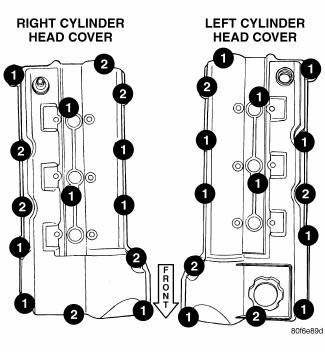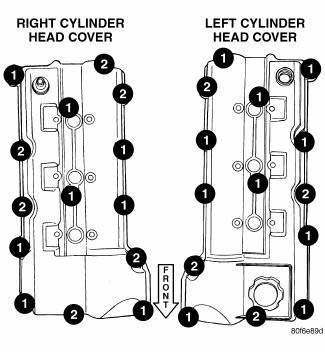Dodge Journey: Lifter(s), hydraulic
Diagnosis and Testing
DIAGNOSIS AND TESTING - HYDRAULIC LASH ADJUSTER NOISE DIAGNOSIS
Proper noise diagnosis is essential in locating the source of a NVH complaint. Locating a lash adjuster (tappet) type noise can sometimes be difficult. As a result, an initial misdiagnosis may occur.
Refer to LASH ADJUSTER (TAPPET) NOISE CHART indicating possible lash adjuster (tappet) noise sources and possible sources that could lead to a misdiagnosis.
Refer to LASH ADJUSTER (TAPPET) NOISE CHART for possible causes and correction of a lash adjuster (tappet) type noise.
LASH ADJUSTER (TAPPET) NOISE CHART
| POSSIBLE CAUSES | CORRECTION |
| 1. Engine oil level-too high or too low. This may cause aerated oil to enter the adjusters and cause them to be spongy. | 1. Check and correct engine oil level. |
| 2. Insufficient running time after rebuilding cylinder head. | 2. Low speed running of up to 1 hour may be required to fully evacuate trapped air from the valve train system. During this time, turn engine off and let set for a few minutes before restarting. Repeat this several times after engine has reached normal operating temperature. |
| 3. Air trapped in lash adjuster (after 1 hour run time). | 3. See below: (a) Check lash adjusters for sponginess while installed in cylinder head. Depress part of rocker arm over adjuster. Normal adjusters should feel very firm. Very spongy adjusters can be bottomed out easily. (b) If lash adjuster(s) are still spongy, replace with new adjuster/rocker arm assembly. |
| 4. Low oil pressure | 4. See below: (a) Check and correct engine oil level. (b) Check engine oil pressure. (c) Check for excessive bearing clearance and correct. (d) Check for worn oil pump. |
| 5. Oil passage to cylinder head(s) plugged with debris. | 5. Check cylinder head oil passages and cylinder head gasket restrictor for blockage. Clean or replace as necessary. |
| 6. Worn valve guide(s). | 6. Ream guide(s) and replace valve(s) with oversize valves and seal(s). |
| 7. Air injested into oil due to broken or cracked oil pump pickup tube. | 7. Inspect pickup tube and replace as necessary. |
| 8. Collapsed lash adjuster due to debris injestion. | 8. Clean debris from engine and replace lash adjuster(s). |
REMOVAL

Fig. 131: Cylinder Head Cover Fasteners
- - DOUBLE ENDED STUDS
- - BOLTS
1. Remove cylinder head cover(s).
CAUTION: If lash adjusters and rocker arms are to be reused, always mark position for reassembly in their original positions.
2. Remove rocker arm(s).
3. Remove lash adjuster(s).
INSTALLATION

Fig. 132: Cylinder Head Cover Fasteners
- - DOUBLE ENDED STUDS
- - BOLTS
1. Install hydraulic lash adjuster making sure adjusters are at least partially full of oil. This can be verified by little or no plunger travel when lash adjuster is depressed.
2. Install the rocker arm(s).
3. Install the cylinder head covers.
 Cover(s), cylinder head, right
Cover(s), cylinder head, right
REMOVAL
1. Disconnect negative battery cable.
Fig. 126: Engine Harness Retaining Clips
- Left cylinder head cover engine harness retainers
- Right cylinder head cover engine harness retainer ...
 Rocker arm, valve
Rocker arm, valve
DESCRIPTION
Fig. 133: Rocker Arm
- LASH ADJUSTER POCKET
- OIL SQUIRT HOLE
- ROLLER
The rocker arms are composed of steel stamping with an integral roller
bearing. The rocker arms incor ...
See also:
Flexplate
Removal
Fig. 198: Flex Plate
1. Remove transmission.
2. Remove flex plate attaching bolts (2).
3. Remove backing plate (3) and flex plate (1).
Installation
Fig. 199: FLEX PLATE
1. Posit ...
ENGINE BLOCK HEATER — IF EQUIPPED
The engine block heater warms engine coolant and
permits quicker starts in cold weather. Connect the cord
to a standard 110-115 Volt AC electrical outlet with a
grounded, three-wire extension cord. ...
DOOR LOCKS
Manual Door Locks
To lock each door, push the door lock plunger on each
door trim panel downward. To unlock the front doors,
pull the inside door handle to the first detent. To unlock
the rear doo ...
